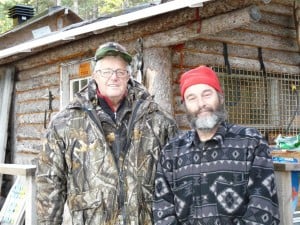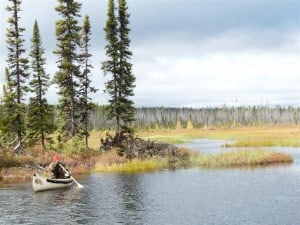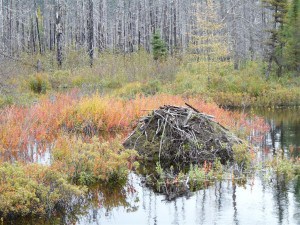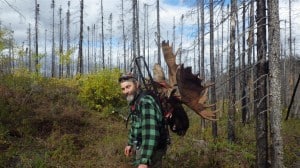A naturalist on the Moose hunt – part one
I had rarely experienced such intense silence. Yes, there were sounds, but they were the sounds of undisturbed nature – the whispering of spruce and birch swaying in the wind, the harsh chatter of a disgruntled Red Squirrel and the loud whistles of a Gray Jay. This was the resonance of nature at its most natural – a soundscape that is nearly impossible to find these days. Obtrusive, man-made sounds were completely absent, save the passing of a float plane once or twice a day. But there was one group of sounds in particular that I was hoping to hear – the grunting, moaning and thrashing of Moose during the rut.
In mid-September, I made the 1500 kilometre trip to the Manicouagan Reservoir in northeastern Quebec to experience a Moose hunt. This man-made lake is located at approximately 51 degrees north latitude, between Baie Comeau and the Labrador border. The hunt camp itself is on l’Ile Rene-Levasseur, a huge island in the centre of the lake. The lake and island are clearly visible from space and are sometimes called the “eye of Quebec.” For many years, my friend Raynald Pilon, a physician in Fermont, Quebec, had regaled me with stories of his annual Moose hunt, the incredible emotions involved and the stark beauty of the boreal forest landscape. This year, I was invited to come and join Raynald and his long-time hunting companion, Claude Moisan, to see why they are so passionate about la “chasse a l’orignal.”
Some people may be surprised that I should want to take part in a hunt. However, I have never been opposed to most types of sustainable hunting. I also don’t want to be a hypocrite. I still eat red meat on occasion and realize that someone has to kill the animal. Hunters simply eliminate this middle man. Secondly, I would probably never have become a naturalist if it wasn’t for a hunter. The late Maurice Clarkson, a well-known Peterborough physician and avid duck hunter, was also a very knowledgeable birder. He used to take me and his son, Peter, on bird-watching outings and taught us a lot about identification.
One of the world’s most influential ecologists and environmentalists, Aldo Leopold, enjoyed hunting, too. In his famous book “A Sand County Almanac” (1949), there is a wonderful essay on Ruffed Grouse hunting entitled “Smoky Gold.” Beautifully composed, Leopold describes his love of season, of trees – especially the smoky gold Tamaracks of October – and his love of grouse hunting. Not only have his ethics of nature and wildlife preservation had a profound impact on the environmental movement but reading Aldo Leopold was largely what inspired me to write my first book, “Nature’s Year in the Kawarthas.”
Hunting, for most of our evolutionary history, was the way in which humans experienced nature. Only in recent decades have large numbers of us had the luxury of the free time and resources to enjoy the natural world as mostly a leisure pursuit. Still, I am well aware that hunters and naturalists/environmentalists are often at odds with one another. I was therefore hoping that by experiencing a Moose hunt, I would discover more about what these two groups have in common and where they differ.
Having taught in this part of Quebec for two years in the late 1970s, I knew that rediscovering the flora and fauna of the boreal forest would be a treat in itself. Moose or no Moose, I would not be bored. As Raynald and I made the one hour hike from his main camp on the shore of Rene-Levasseur Island to his smaller hunting and fishing camp on Lac Fourchette, it was like reacquainting myself with old friends. I had forgotten just how different the boreal forest is from the forests we are used to in the Kawarthas. First of all, thee vast majority of the trees are conifers, with Black Spruce the dominant species. There are also smaller pockets of White Spruce, Balsam Fir, Tamarack (Larch) and Jack Pine. As for broad-leaved species, these are limited to scattered stands of Trembling Aspen and White Birch.
But the understory is what I find most interesting. It is made up primarily of shrubs in the Ericaceae family (heathers), a group of flowering plants most common acid and infertile growing conditions. These include abundant Labrador Tea, Sheep-laurel and Blueberry. This year, the Blueberries were so heavily laden with fruit that you could literally pull off a handful with one swipe of the hand. Other common understory species include Bunchberry (its red berries almost looking like drops of blood on the ground), Swamp Birch, Swamp Red Currant, Twinflower, Squashberry, Black Chokeberry, Mountain Alder, Speckled Alder, willows, cranberries and a host of different mosses and lichens. In fact, the mosses and lichens form a vast, mattress-like green carpet over the forest floor that almost beckons you to lie down and have a nap. Sorting out all of the different species, however, will have to wait for a future trip.
It is estimated that the avian population of the boreal represents 60% of the landbirds in all of Canada. However, by mid-September, the majority of these have already departed for more southern climes. The species I saw and heard most often was the Gray Jay, also known as the Canada Jay. Most days, we also encountered Spruce Grouse, Dark-eyed Juncos, Golden-crowned Kinglets and White-throated Sparrows. A Common Raven occasionally passed over and both a Bald Eagle and Northern Goshawk put in an appearance. Migrating flocks of American Robins and Bohemian Waxwings were also seen on several occasions. On Lac Fourchette, a family group of Common Loons kept us company, as did three Common Mergansers. As for mammals, Red Squirrels were a constant presence and Beaver ponds, dams and lodges were everywhere. Judging by the amount of scat we saw, Gray Wolves were certainly in the area, as well. Some of the scat contained bones as big as quarters. Most importantly for our purposes, however, the island also has a healthy Moose population. Raynald and Claude kill a bull, cow or calf most years and signs of Moose activity are usually fairly easy to find. We were therefore watching closely for recent tracks, droppings, browsed shrubs and both rubs and scrapes on tree bark.
The camp itself was quite a site, especially for the uninitiated like me. A huge rack of Moose antlers adorned one of the exterior walls and, to keep bears out, an “unwelcome mat” of upward pointing nails was placed in front of the door. The windows were covered with steel bars. Inside, there was another, even larger, rack of antlers, a dining area and a bedroom with bunks. The table, counters, chairs, walls, beds and floor were littered with everything you could conceivably need to have a comfortable, safe and successful hunt. I think this is when I fully realized just how far out of my comfort zone I had wandered. Not only do I know relatively little about rifles and hunting, but I’m not terribly technically-minded. Here I was immersed in a world of outdoor motors, batteries of all kinds, chargers, generators, gun paraphernalia, walkie-talkies, satellite phones, GPSs and esoteric talk of hunting techniques. What was most intimidating, however, was having to quickly familiarize myself with hunt camp rituals and do’s and don’ts dating back 30 years – and all of this in French. To add another twist, it was the first time a third person had joined Raynald and Claude on the hunt. And not just any third person, but an Anglais who’s not a hunter! I had set myself up to feel, well, kind of dumb.
There was also a moral dilemma that I had not yet addressed. Raynald explained to me that we would each be hunting separately and that there was every possibility that I might encounter a Moose on my own. I was therefore provided with a gun. What would I do? Would I shoot and probably feel guilty about having killed such a majestic animal? But, the implications of not shooting were grave, as well. The last thing these guys wanted was for me to come waltzing in the door at the end of the day to show them some beautiful Moose photos. Yes, this was serious business and I was expected to do my part in assuring a successful hunt. To be continued



